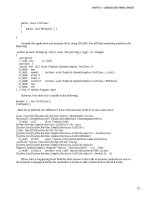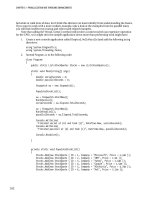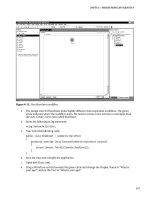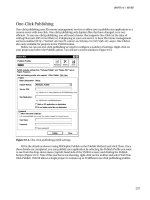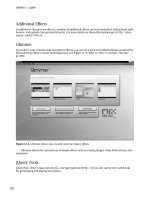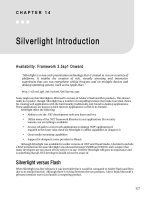Beginning WF Windows Workflow in .NET 4.0 pptx
Bạn đang xem bản rút gọn của tài liệu. Xem và tải ngay bản đầy đủ của tài liệu tại đây (5.14 MB, 471 trang )
www.it-ebooks.info
Beginning WF
Windows Workflow in .NET 4.0
n n n
Mark J. Collins
www.it-ebooks.info
Beginning WF: Windows Workflow in .NET 4.0
Copyright © 2010 by Mark J. Collins
All rights reserved. No part of this work may be reproduced or transmitted in any form or by any means,
electronic or mechanical, including photocopying, recording, or by any information storage or retrieval
system, without the prior written permission of the copyright owner and the publisher.
ISBN-13 (pbk): 978-1-4302-2485-3
ISBN-13 (electronic): 978-1-4302-2486-0
Printed and bound in the United States of America 9 8 7 6 5 4 3 2 1
Trademarked names may appear in this book. Rather than use a trademark symbol with every
occurrence of a trademarked name, we use the names only in an editorial fashion and to the benefit of
the trademark owner, with no intention of infringement of the trademark.
President and Publisher: Paul Manning
Lead Editor: Jonathan Hassell
Technical Reviewer: Michael Mayberry
Editorial Board: Clay Andres, Steve Anglin, Mark Beckner, Ewan Buckingham, Gary Cornell,
Jonathan Gennick, Jonathan Hassell, Michelle Lowman, Matthew Moodie, Duncan Parkes,
Jeffrey Pepper, Frank Pohlmann, Douglas Pundick, Ben Renow-Clarke, Dominic Shakeshaft,
Matt Wade, Tom Welsh
Project Manager: Debra Kelly
Copy Editor: Nancy Sixsmith
Compositor: Laureltech
Indexer: BIM Indexing & Proofreading Services
Artist: April Milne
Cover Designer: Anna Ishchenko
Distributed to the book trade worldwide by Springer-Verlag New York, Inc., 233 Spring Street, 6th Floor,
New York, NY 10013. Phone 1-800-SPRINGER, fax 201-348-4505, e-mail , or
visit www.springeronline.com.
For information on translations, please e-mail , or visit www.apress.com.
Apress and friends of ED books may be purchased in bulk for academic, corporate, or promotional use.
eBook versions and licenses are also available for most titles. For more information, reference our
Special Bulk Sales–eBook Licensing web page at www.apress.com/info/bulksales.
The information in this book is distributed on an “as is” basis, without warranty. Although every
precaution has been taken in the preparation of this work, neither the author(s) nor Apress shall have
any liability to any person or entity with respect to any loss or damage caused or alleged to be caused
directly or indirectly by the information contained in this work.
The source code for this book is available to readers at www.apress.com.
www.it-ebooks.info
Dedicated to my wife, Donna. Your worth is far above rubies (Prov 31:10). I love you!
www.it-ebooks.info
v
Contents at a Glance
Contents vii
About the Author xix
About the Technical Reviewer xx
Acknowledgments xxi
Introduction xxii
n Part 1: Introduction 1
n Chapter 1: Building a Simple Workflow 3
n Chapter 2: Coded Workflows 23
n Chapter 3: Flowchart Workflow 33
n Part 2: Designing Workflows 43
n Chapter 4: Passing Arguments 45
n Chapter 5: Replicated Activities 59
n Chapter 6: Exception Handling 69
n Chapter 7: Extending the Built-In Activities 79
n Part 3: Communication 93
n Chapter 8: Send and Receive 95
n Chapter 9: Communicating with the Host Application 123
n Chapter 10: Web Services 151
www.it-ebooks.info
n CONTENTS AT A GLANCE
vi
n Part 4: Workflow Extensions 175
n Chapter 11: SQL Persistence 177
n Chapter 12: Custom Extensions 209
n Chapter 13: Tracking 229
n Chapter 14: Transactions 255
n Chapter 15: Transactions with Persistence 277
n Chapter 16: WorkflowServiceHost 289
n Part 5: Advanced Topics 317
n Chapter 17: Compensation, Confirmation, and Cancellation 319
n Chapter 18: Collections 345
n Chapter 19: Interoperability with Workflow 3.5 361
n Chapter 20: Policy 375
n Appendix: Sample Workflow Project 405
n Index: 439
www.it-ebooks.info
vii
Contents
About the Author xix
About the Technical Reviewer xx
Acknowledgments xxi
Introduction xxii
n Part 1: Introduction 1
n Chapter 1: Building a Simple Workflow 3
A Simple Workflow 4
Exploring the IDE 4
Designing the Workflow 5
Reviewing Program.cs 6
Running the Application 7
Adding Procedural Elements 7
Using Variables 8
If 10
Assign 11
While 12
Sequence 13
Delay 13
More Embellishments 14
Running the Application 15
www.it-ebooks.info
n CONTENTS
viii
Navigating the Designer 15
Looking a Bit Deeper 17
Differences from Previous Versions 21
n Chapter 2: Coded Workflows 23
Creating a Console Application 23
Defining the Workflow 24
Implementing Level 1 25
Implementing Level 2 26
Implementing Level 3 28
Running the Application 29
Review 32
n Chapter 3: Flowchart Workflow 33
Creating a Flowchart Workflow 33
Designing the Flowchart 34
Defining Connections 34
FlowDecision 35
Running the Application 37
Flow Switch 38
Adding a FlowSwitch Activity 38
Adding the FlowStep Activities 39
Running the Application 40
Parallel 40
Adding a Parallel Activity 40
Adding the Branches 41
Running the Application 42
n Part 2: Designing Workflows 43
n Chapter 4: Passing Arguments 45
Creating a New Solution 45
www.it-ebooks.info
n CONTENTS
ix
Defining the Order Class 46
Implementing the Workflow 48
Defining the Arguments 49
Designing the Workflow 51
Switch Activity 51
Expression Activities 53
Invoking the Workflow 56
Running the Application 58
n Chapter 5: Replicated Activities 59
Reusing the Chapter 4 Project 59
Adding OrderItem Processing 61
ForEach Activity 61
Adding Order Items 65
Running the Application 66
ParallelForEach Activity 68
n Chapter 6: Exception Handling 69
Reusing the Chapter 5 Project 69
Adding the Check Stock Activity 70
TryCatch Activity 70
Defining an Exception 70
ForEach Activity 72
If Activity 72
Throw Activity 73
Catch Activity 74
Running the Application 76
Exceptions 77
n Chapter 7: Extending the Built-In Activities 79
Reusing the Chapter 6 Project 79
www.it-ebooks.info
n CONTENTS
x
Using Custom Activities 80
Implementing a Custom Activity 80
Using the LookupItem Activity 82
Running the Application 85
InvokeMethod Activity 86
Creating a Discount Class 86
Using the InvokeMethod Activity 87
Adding the Discount 91
Running the Application 91
Summary 92
n Part 3: Communication 93
n Chapter 8: Send and Receive 95
Creating the Project 95
Define the Messages 96
Application Configuration 101
Defining the Workflows 102
Client–SendRequest 102
Server–ProcessRequest 107
Implementing the Application 114
WorkflowServiceHost 114
WorkflowInvoker 116
Running the Application 118
Configuring a Library Branch 118
Expected Results 120
n Chapter 9: Communicating with the Host Application 123
Creating a WPF Project 123
Reusing the Classes from Chapter 8 124
Defining the Window Form 125
www.it-ebooks.info
n CONTENTS
xi
Implementing a TextWriter 127
Providing a Static Application Reference 128
Implementing ListBoxTextWriter 129
Implementing the Workflows 131
Listening for Messages 132
Bookmarks 135
Implementing the SendRequest Workflow 137
Implementing the ProcessRequest Workflow 139
Implementing the Application 141
Maintaining Workflow Instances 141
Event Handlers 142
ApplicationInterface Methods 143
Running the Application 148
n Chapter 10: Web Services 151
Creating a Workflow Service 151
Defining the Service Contract 152
Configuring Receive and SendReply 155
Creating the PerformLookup Activity 158
Testing the Service 161
Using Parameters 162
Creating a Second Service 163
Creating a Modified PerformLookup Activity 166
Testing the Service 167
Creating a Client Workflow 168
Defining the Workflow 170
Implementing the Host Application 171
Running the Application 172
Using Pick 173
Review 174
www.it-ebooks.info
n CONTENTS
xii
n Part 4: Workflow Extensions 175
n Chapter 11: SQL Persistence 177
Creating the Application 177
Renaming the Window 178
Defining the Window Form 178
Implementing a TextWriter 181
Setting Up the Database 185
Creating a Database 185
Installing the Schema 185
Creating the LINQ to SQL Classes 188
Designing the Workflow 191
Custom CreateLead Activity 191
Custom WaitForInput Activity 193
Defining the Workflow Activities 193
Implementing the Application 195
Application Configuration File 196
Configuring the Persistence Provider Factory 196
Creating Leads 197
Assigning Leads 198
Loading Existing Leads 200
Running the Application 204
Digging a Bit Deeper 206
Persisting Arguments and Variables 207
n Chapter 12: Custom Extensions 209
Setting Up the Solution 209
Copy Solution from Chapter 11 209
Setting Up the Database 210
Implementing SetupInstance 210
Running the Application 211
www.it-ebooks.info
n CONTENTS
xiii
Extensions 211
Implementing a Simple Extension 211
Configuring the Extension 212
Using the Extension in an Activity 213
Updating the Application 214
Participating in Persistence 215
Creating the Extension 215
PersistenceParticipant 216
AddComment Activity 216
Modifying the Workflow 218
Accessing the Extension from the Application 218
Event Handler Syntax 219
Running the Application 220
n Chapter 13: Tracking 229
Setting Up the Solution 229
Copy Solution from Chapter 12 230
Setting Up the Database 230
Tracking Participants 230
ListBoxTrackingParticipant 230
Overriding the Track() Method 232
Configuring a Tracking Participant 233
Configuring a Tracking Profile 234
CustomTrackingRecord 236
Running the Application 238
Event Tracing for Windows (ETW) 238
Setting Up the Extension 238
Configuring the TrackingProfile 239
Running the Application 239
SqlTrackingParticipant 241
Setting up the Database 241
www.it-ebooks.info
n CONTENTS
xiv
Implementing the SqlTrackingParticipant 243
Configuring the Tracking Participant 245
Running the Application 247
n Chapter 14: Transactions 255
Setting Up the Solution 255
Assignments 256
Adding the LINQ to SQL Class 256
AssignLead Activity 258
CreateAssignment Activity 260
Application Changes 262
Updating the List of Leads 262
Removing Database Updates 263
Adding Workflow Event Handlers 264
Workflow Changes 272
TransactionScope 273
InvokeMethod 273
Running the Application 276
n Chapter 15: Transactions with Persistence 277
Setting Up the Solution 277
PersistenceParticipant 278
PersistLead Extension 278
Connecting to the Database 281
Performing the Updates 281
Using the PersistLead Extension 281
Modifying the CreateLead Activity 282
Modifying the AssignLead Activity 283
PersistAssignment Extension 284
Using the PersistAssignment Extension 286
www.it-ebooks.info
n CONTENTS
xv
Application Changes 287
Running the Application 287
n Chapter 16: WorkflowServiceHost 289
Setting Up the Solution 289
Adding LeadResponse 290
Renaming the Window 291
Defining the Window Form 291
Copying Classes from LeadGenerator 294
Implementing the Application 294
WorkflowService 300
Behaviors 301
DBExtensionBehavior 301
PersistAssignmentBehavior 303
Defining the Workflows 304
CompleteAssignment 304
EnterLead Workflow Modifications 305
WorkAssignment Workflow 308
Persist 311
Final Application Changes 311
ApplicationInterface 311
Adding the app.config File 312
LINQ Conflict 313
Running the Applications 314
Review 316
n Part 5: Advanced Topics 317
n Chapter 17: Compensation, Confirmation, and Cancellation 319
Designing the Workflow 320
Modifying the Application 320
www.it-ebooks.info
n CONTENTS
xvi
Configuring a TryCatch Activity 322
Using a Parallel Activity 323
CompensableActivity 324
Designing the Wedding Activity 325
Designing the Reception Activity 327
Designing the Invitations Activity 328
Running the Application 330
Cancellation Handlers 331
More on the Parallel Activity 331
Designing Compensation Handlers 332
Designing the Wedding Compensation 332
Designing the Reception Compensation 333
Running the Application 334
Customizing Compensation and Confirmation 337
Adding the Token Variables 337
Setting the Result Property 349
Custom Confirmation 339
Custom Compensation 341
Rethrow Activity 342
n Chapter 18: Collections 345
Creating a Collection 345
Defining the Shopping List 346
Initial Workflow 346
AddToCollection Activity 348
Invoking a Workflow 348
Running the Application 349
Printing and Sorting 349
Printing the Collection 349
Sorting the Collection 351
www.it-ebooks.info
n CONTENTS
xvii
Searching the Collection 353
Overriding the Equals() Method 353
ExistsInCollection Activity 354
RemoveFromCollection Activity 355
ClearCollection Activity 355
n Chapter 19: Interoperability with Workflow 3.5 361
Creating a 4.0 Workflow 361
Creating a 3.5 Workflow 362
Interop Activity 366
Running the Application 367
Executing a Custom 3.5 Activity 367
Creating a Custom Activity 368
Throwing an Exception 370
Invoking the Custom Activity 371
Running the Application 374
n Chapter 20: Policy 375
Creating a Custom Activity 375
Defining the Data Structures 376
PolicyActivity 379
Adding Dependency Properties 380
Creating a Rule Set 383
Defining the Rules 384
Understanding Rule Sets 387
Determining the Priority 390
Entering the Priority Rules 391
Creating a Workflow Application 392
Creating a Custom Activity 393
Incrementing the Activity Counters 396
Creating the Main Workflow 400
www.it-ebooks.info
n CONTENTS
xviii
Configuring the Arguments 400
Implementing the Console Application 402
Running the Application 403
Review 403
n Appendix: Sample Workflow Project 405
Project Overview 405
Configuring the Database 405
Running the Application 406
Generic Queue Logic 413
Database Design 414
Activities 415
CompleteInstance 415
QCPolicy 416
Tracking 418
Service Layer 420
Service Contract 420
Database Design 422
Activities 423
Workflow Design 424
Correlation 428
Using WorkflowServiceHost 430
Summary 437
n Index: 439
www.it-ebooks.info
xix
About the Author
n Mark Collins wrote his first software program using Basic on the TRS-80 in 1978.
As technology has evolved, so has his interest and enjoyment of this wonderful
world of software. Mark’s career has included many varied opportunities, including
being an electrical engineer for IBM, being a system acquisition officer for the U.S.
Air Force, spending 12 years designing and building world-class point-of-sale
solutions, spending a two-year stint in Engand, and (most recently) providing
donor management systems for two well-known nonprofit organizations. Mark has
also developed a CASE tool called Omega Tool (www.TheCreativePeople.com).
www.it-ebooks.info
n CONTENTS
xx
About the Technical Reviewer
n Michael Mayberry currently helps lead a software team for a nonprofit organization to build .NET
enterprise applications. He serves as a lead architect and focuses on adopting new technologies toward
solid solutions. Michael’s experience includes the development of web-based extranet solutions, along
with data collection and analysis applications within the auto industry. Michael moved to build CRM
and BI solutions for the nonprofit industry more than seven years ago.
www.it-ebooks.info
xxi
Acknowledgments
First of all, I want to acknowledge that anything that I have ever done that is of any value or significance
was accomplished through the blessings of my Lord and Savior, Jesus Christ. This book is a visible
demonstration of that fact. The challenges in a project such as this were beyond my own ability, and
God’s amazing grace carried me through. He is my strength, my vision, and my provider.
Next, I want to say a big “thank you” to my beautiful wife, Donna. You are an inspiration to me. You
selflessly took care of our household and encouraged me to focus on this book. I could not have done it
without you. You are the embodiment of a Proverbs 31 wife. I am truly blessed to be able to share my life
with you.
I am also very thankful for all the people at Apress who made this book possible and for all their hard
work that turned it into the finished product you see now. Through numerous rewrites and revisions you
were always helpful, patient, and encouraging. Thank you!
I also want to thank Kevin Belknap, who helped me with the web application for the sample solution in
the appendix. You always know how to make a site look great! Thank you for eagerly helping with this
project.
Finally, I want to thank Michael Mayberry for reviewing this book. Not only did you review this book, but
you also had to review several preliminary versions, which no one will probably ever see. I appreciate
your heart that strives for excellence, your humility, and your selflessness.
www.it-ebooks.info
n CONTENTS
xxii
Introduction
When I first started looking at Microsoft’s Workflow Foundation (WF) I had a sense that there was
something really useful there, but figuring out the right application of the technology seemed elusive.
The available code samples demonstrated some specific features, but there was no roadmap to help
bring it all together. So I started writing this book to help others who wanted to understand WF.
Along the way, the first beta release of WF 4.0 was made available, which was a complete departure from
the previous version. So the first book based on version 3.5 was shelved, and I started writing a new book
for WF 4.0. When the second Beta was released with significant changes, the book was once again
rewritten. Having watched WF evolve from version 3.5 to 4.0 B1 and then 4.0 B2, and finally 4.0 RC, I can
confidently say that these improvements will make your job as a workflow developer much easier.
How to Use This Book
An ancient proverb says, “Tell me and I’ll forget; show me and I may not remember; involve me and I’ll
understand.” Based on this truth, this book presents a series of workflow projects; starting with simple
solutions and gradually increasing in complexity. New concepts are introduced in each chapter. In each
project, I’ll show you step-by-step how to implement them for yourself. I recommend that you work
through each chapter in order because each chapter builds on both concepts and code that was
developed in previous chapters.
As an alternative, you can download the final implementation of each chapter from www.apress.com. You
can then read the book and follow along with the downloaded code. This approach is recommended for
more experienced developers who are looking for a quick tutorial or perhaps an explanation of specific
concepts.
In either case, once you have read the book and are starting to implement workflow in your own
solutions, the sample projects provided in this book make a handy reference guide. A topical reference is
provided to help you find the appropriate chapters to look at for each of the WF concepts.
Several of the projects require a SQL Server database. Just about any version will work, including the
Microsoft Data Engine (MSDE) provided with Visual Studio. You will need to create the databases and
configure the appropriate connection strings. You can download the database scripts from
www.apress.com, which provide everything you’ll need to create the schemas.
www.it-ebooks.info
n INTRODUCTION
xxiii
Chapter Outline
This book’s projects (chapters) are grouped into five sections. In many cases, the same solution is
provided in all chapters in that section, with each chapter providing new features to the project from the
previous chapter.
Section 1: Basic Concepts
In the first section, you’ll build three simple workflows. In Chapter 1, you’ll create a workflow using the
workflow designer and some of the basic built-in activities. In Chapter 2, you’ll re-create the same
workflow in code. This will give you an opportunity early on to see both designer workflows and coded
workflows. Both types will be demonstrated throughout the book. In Chapter 3, you’ll use the flowchart
activity, which provides the ultimate flexibility in designing complex workflows.
Section 2: Designing Workflows
In the second section, you’ll build a workflow that computes the cost of an order. Each chapter will add
additional features to the project from the previous chapter. The project in Chapter 4 demonstrates how
to pass data into and out of a workflow. In Chapter 5, you’ll interactively execute activities based on a
collection of objects. Chapter 6 will show you how to handle and throw exceptions. In Chapter 7, you’ll
explore the two main ways to extend the workflow activities: creating a custom activity and executing the
InvokeMethod activity.
Section 3: Communication
In the third section, you’ll build workflows that take advantage of the integration with the Windows
Communication Foundation (WCF). The project in Chapter 8 builds a console application that
communicates with other instances of the same application using WCF messages. In Chapter 9, the
console app is replaced with a Windows Presentation Foundation (WPF) application, which
demonstrates how the application and workflow can interact with each other. In Chapter 10, you’ll host
a workflow in a WCF web service. You’ll also consume that service using a workflow application.
Section 4: Workflow Extensions
A key component of workflow design is the use of extensions to configure the environment in which the
workflow activities operate. The project in Chapter 11, for instance, demonstrates how to use the
standard SQL persistence extension. This extension allows the state of the workflow to be written to a
SQL database and retrieved later, when the workflow is resumed. In Chapter 12, you’ll explore ways to
extend and customize the persistence operation. The project in Chapter 13 demonstrates how to track
the execution of a workflow in a variety of ways. In Chapter 14, you’ll use database transactions to ensure
data consistency across multiple activities. In Chapter 15, you’ll execute the application updates on the
same database transaction used to persist the workflow state. This will guarantee that the workflow state
and application data stay consistent. Finally, in Chapter 16, you’ll learn how to configure extensions
when the workflow is instantiated by a WorkflowServiceHost.
www.it-ebooks.info
n INTRODUCTION
xxiv
Section 5: Advanced Topics
Chapter 17 demonstrates how to include logic within the workflow design to handle abnormal
conditions such as compensation and cancellation. In Chapter 18, you’ll see how to use both built-in
and custom activities to support collections of objects. The project in Chapter 19 uses the Interop
activity to execute workflows and activities that were created using previous versions of WF. In Chapter
20, you’ll use the Policy activity from version 3.0 in a WF 4.0 workflow.
Appendix
The Appendix describes a sample workflow that demonstrates many of the concepts presented in this
book. It is designed as a review of the key concepts while providing another example of a workflow
implementation. This project is not described in a step-by-step fashion. Instead, the final code can be
downloaded from www.apress.com.
www.it-ebooks.info
PART 1
■ ■ ■
Introduction
The Workflow Foundation included in .Net 4.0 (referred to as WF 4.0) represents a whole
new paradigm for building workflow-based applications. It has been completely re-
engineered from the ground up. In this section, you’ll design some simple workflows and
learn the basic concepts. In subsequent sections, you’ll develop more complex solutions as
you explore the capabilities provided by WF 4.0.
www.it-ebooks.info



